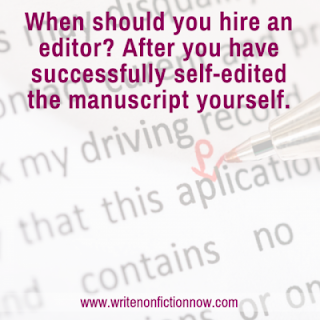You’ve finished the first draft of your nonfiction book or an article for publication. It’s time to hand your manuscript over to an editor, right?
Wrong.
Recently, I met a prospective author who was working on her first book. “So,” she asked, “an editor like you can help me fix up my first draft, right?”
On the one hand, she’s right: a part of my job is, indeed, working with authors to help improve their books. On the other hand, this author’s question reveals a common misconception about the editor-author relationship—that the writer finishes their writing and then hands the work over to an editor to make it into something publishable.
Editors provide sound advice and love to work with authors but can help more if the writers take some necessary steps to revise their work before approaching an editor. Simply said, you must self-edit your work first.
In between the end of your writing process and an editor’s intervention, there are steps you can take to help self-edit your work and bring it one step closer to something that’s ready to go out to readers. Let’s review a few strategies for self-editing that can be useful to you as you get ready to move from writing to editing and, then, publishing.
How to Self-Edit Your Manuscript - Before You Hand it Over to an Editor
1 Take some time away.
Even though you might have edited your work as you worked on the manuscript, when finished, you need to consider it as a whole. After you complete the first draft, take at least twenty-four hours (for a shorter piece) to a week (for a longer piece) entirely away from that work. This allows you to clear from your mind the original thought process you used when you were writing. Then you can just focus on the work itself as a less-familiar piece of writing.
Many writers are afraid to do this because they worry that the writing will seem terrible to them upon re-reading. That’s why you self-edit! Plus, it’s equally as common that you’ll be pleasantly surprised upon a later re-reading and think, “Did I really write this? It’s so good!”
2 Read out loud.
This is a time-worn staple of self-editing advice and for a good reason. Nothing helps to give you a new perception of your own writing like actually hearing it read out loud. If you stumble over a sentence, lose track of the story, or find yourself being bored by a paragraph—you’ll know to flag that for revision.
3 Put your feelings away.
Writing is an emotional process; it’s easy to feel like each individual piece is a stand-in for your overall intelligence, skill, or creativity. Admitting that a sentence isn’t clear or that a section of the piece is off-topic or boring can be painful and feel like you’re admitting to having less ability as a writer than you think or claim to have. It can be equally hard to accept that a turn of phrase you thought was poetic or brilliant before now seems silly or over-the-top.
However, it’s important to remember that the revision process is another opportunity to show your chops as a writer. When you hesitate to make a change or explain away a negative feeling you get from some part of your writing, ask yourself if this is a writerly response or an emotional one. Learn to recognize your emotions as a writer and navigate around them as you self-edit your work.
4 Imagine you’re your own worst critic.
This self-editing strategy works well for those who have learned to separate their writerly instincts from their emotional ones. Read your piece and think of what a very critical reviewer or reader would think. Will they find the tone too sentimental? Will they find the progression of events in the narrative implausible? Make a note of these pitfalls and then look back at the piece of writing to see if these issues could be addressed.
Often, it’s entirely possible to challenge yourself to revise in a way that will satisfy the most skeptical. And the result will make your work better, even though the process of pointing out these flaws to yourself might be painful.
At a minimum, I want to see a second draft—not a first draft—from prospective authors. I want to feel like the writing has been read through and worked on before it got to me. This shows a willingness to develop the writing and an ability to separate their attachment to the work from the needs of the reader.
After all, the reader is the most important part of the equation, and both self-editing and professional editing should work together to get a piece of writing ready for that reader’s comprehension and enjoyment. With these self-editing strategies, you’ll be prepared to do your part in that process.
Once through, you can submit your work to a professional editor. Contact The Ready Writers for professional editing tailored to your manuscript's specific needs.
Culled from Write Non Fiction


No comments:
Post a Comment